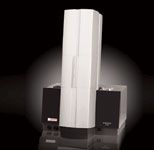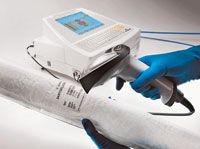In the Spotlight October 2010
Editors' picks of pharmaceutical science and technology innovations.
Even though they do not create final dosage forms, analytical instruments are a crucial part of any pharmaceutical manufacturing line. These devices help confirm the identity of ingredients and ensure consistent quality from batch to batch. Regulators have promoted these instruments' ability to provide companies with greater understanding of their processes. Analytical instruments also can confirm that other equipment is working properly. This month's products illustrate the ways that analytical devices help manufacturers. Hiden's system couples a microreactor with a mass spectrometer. FRITSCH's instrument offers high-resolution analysis of particle size and shape. A filter-integrity tester from Sartorius cleans itself automatically.
Analytical system incorporates two close-coupled modules
Hiden Analytical's (Warrington, UK) CATLAB system combines a microreactor and mass spectrometer with fully integrated control software. The two close-coupled modules are designed to offer continuous real-time analysis of catalytic activity. The system also evaluates various reaction components simultaneously and provides overall response times of less than 0.5 s.

CATLAB system Hiden Analytical www.hidenanalytical.com
The system's fully preprogrammable and automated analysis cycles enable users to control ramp rates, temperature range, temperature dwell periods, gas flows, pulse switching, and the mass spectrometer. More than 4000 processes can be completed in one cycle. The reactor incorporates a bypass channel so that gas flow may be set up and mixtures prepared independently of the sample environment.
Operators can detach the CATLAB system's mass spectrometer easily for use off-line. The high-sensitivity quadrupole mass spectrometer has a detection limit of 0.1 to 1 ppm, subject to spectral interference, and takes as many as 1000 measurements/s.
Instrument analyzes particle size and shape
The ANALYSETTE 22 NanoTec instrument from FRITSCH (Idar-Oberstein, Germany) automatically analyzes particle-size distribution and particle shape. Scientists can move the instrument's measuring cell easily between the Fourier lens and the detector to achieve high resolution. The instrument analyzes coarse materials best when the measuring cell is far from the detector.

ANALYSETTE 22 NanoTec instrument FRITSCH www.fritsch.de
The instrument provides high-resolution images of small particles when the measuring cell is close to the detector. Through a small opening at the center of the detector, a second laser beam irradiates the sample from behind, and backward-scattered light can be captured with full resolution.
Instrument performs many filter-integrity tests
The Sartocheck 4 plus instrument from Sartorius (Goettingen, Germany) performs a battery of filter-integrity tests such as diffusion, bubble point, diffusion–bubble point, water intrusion, water flow, customer-specific bubble point, customer-specific diffusion, and multipoint diffusion. The operator can select the test program manually or use a barcode reader to enter data into test programs. When the operator scans a filter's barcode, the instrument recalls the appropriate test program for that filter automatically. The tester can connect to a network and exports results as PDF files that can be shared easily with other data systems.

Sartocheck 4 plus instrument Sartorius www.sartorius.com
In addition, operators can prompt the tester to clean itself automatically in about an hour. Users add cleaning solution into a separate vessel, and the tester cleans, rinses, and dries its entire pneumatic path. Operators thus do not need to send the instrument to the manufacturer for cleaning, and this feature reduces downtime and cost.

WMFTS’ BioPure to Showcase Single-Use Bioclamp with Refined Manufacturing at INTERPHEX 2025
April 1st 2025With advanced manufacturing, BioPure’s BioClamp connector is manufactured to be 13% lighter than the previous model, resulting in a 26% reduction in carbon dioxide emissions across the full lifecycle of the product.
Drug Solutions Podcast: A Closer Look at mRNA in Oncology and Vaccines
April 30th 2024In this episode fo the Drug Solutions Podcast, etherna’s vice-president of Technology and Innovation, Stefaan De Koker, discusses the merits and challenges of using mRNA as the foundation for therapeutics in oncology as well as for vaccines.